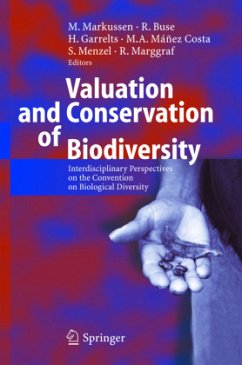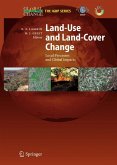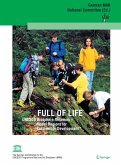Michael Markussen / Ralph Buse / Heiko Garrelts / María A. Manez Costa / Susanne Menzel / Rainer Marggraf (eds.)Interdisciplinary Perspectives on the Convention on Biological Diversity
Valuation and Conservation of Biodiversity
Interdisciplinary Perspectives on the Convention on Biological Diversity
Herausgegeben:Markussen, Michael; Buse, Ralph; Garrelts, Heiko; Manez Costa, María; Menzel, Susanne; Marggraf, Rainer
Michael Markussen / Ralph Buse / Heiko Garrelts / María A. Manez Costa / Susanne Menzel / Rainer Marggraf (eds.)Interdisciplinary Perspectives on the Convention on Biological Diversity
Valuation and Conservation of Biodiversity
Interdisciplinary Perspectives on the Convention on Biological Diversity
Herausgegeben:Markussen, Michael; Buse, Ralph; Garrelts, Heiko; Manez Costa, María; Menzel, Susanne; Marggraf, Rainer
- Gebundenes Buch
- Merkliste
- Auf die Merkliste
- Bewerten Bewerten
- Teilen
- Produkt teilen
- Produkterinnerung
- Produkterinnerung
Main description:
The goal of this transdisciplinary book is to identify the problems and challenges facing implementation of the Convention on Biological Diversity (CBD) - from the global, regional and local points of view. The valuation and conservation of biodiversity constitute critical first steps necessary for the adequate protection of the environment. The authors give insights into the current trends in this field and on the influences the CBD exerts.
Table of contents:
Part I: Global and general perspectives on the Convention on Biological Diversity.- Part II: Local, regional…mehr
Andere Kunden interessierten sich auch für
![Adaptation and Evolution in Marine Environments, Volume 1 Adaptation and Evolution in Marine Environments, Volume 1]() Adaptation and Evolution in Marine Environments, Volume 181,99 €
Adaptation and Evolution in Marine Environments, Volume 181,99 €![Nature Conservation Nature Conservation]() Dan Gafta (Volume ed.) / John R. AkeroydNature Conservation121,99 €
Dan Gafta (Volume ed.) / John R. AkeroydNature Conservation121,99 €![Land-Use and Land-Cover Change Land-Use and Land-Cover Change]() Eric F. Lambin / Helmut J. Geist (eds.)Land-Use and Land-Cover Change150,99 €
Eric F. Lambin / Helmut J. Geist (eds.)Land-Use and Land-Cover Change150,99 €![Full of Life Full of Life]() German MAB National Committee (ed.)Full of Life25,99 €
German MAB National Committee (ed.)Full of Life25,99 €![Ecosystem Function in Heterogeneous Landscapes Ecosystem Function in Heterogeneous Landscapes]() Gary M. Lovett / Clive G. Jones / Monica G. Turner / Kathleen C. Weathers (eds.)Ecosystem Function in Heterogeneous Landscapes189,99 €
Gary M. Lovett / Clive G. Jones / Monica G. Turner / Kathleen C. Weathers (eds.)Ecosystem Function in Heterogeneous Landscapes189,99 €![Unsere Böden entdecken - Die verborgene Vielfalt unter Feldern und Wiesen Unsere Böden entdecken - Die verborgene Vielfalt unter Feldern und Wiesen]() Axel DonUnsere Böden entdecken - Die verborgene Vielfalt unter Feldern und Wiesen25,00 €
Axel DonUnsere Böden entdecken - Die verborgene Vielfalt unter Feldern und Wiesen25,00 €![Biogeochemistry of Forested Catchments in a Changing Environment Biogeochemistry of Forested Catchments in a Changing Environment]() Egbert Matzner (ed.)Biogeochemistry of Forested Catchments in a Changing Environment249,99 €
Egbert Matzner (ed.)Biogeochemistry of Forested Catchments in a Changing Environment249,99 €-
-
Main description:
The goal of this transdisciplinary book is to identify the problems and challenges facing implementation of the Convention on Biological Diversity (CBD) - from the global, regional and local points of view. The valuation and conservation of biodiversity constitute critical first steps necessary for the adequate protection of the environment. The authors give insights into the current trends in this field and on the influences the CBD exerts.
Table of contents:
Part I: Global and general perspectives on the Convention on Biological Diversity.- Part II: Local, regional and nationwide perspectives on the Convention on Biological Diversity: Examples from Germany.- Part III: Local, regional and nationwide perspectives on the Convention on Biological Diversity: Examples from Guatemala.- Part IV: Epilogue: A general perspective on the evaluation of interdisciplinary research.
The goal of this transdisciplinary book is to identify the problems and challenges facing implementation of the Convention on Biological Diversity (CBD) - from the global, regional and local points of view. The valuation and conservation of biodiversity constitute critical first steps necessary for the adequate protection of the environment. The authors give insights into the current trends in this field and on the influences the CBD exerts.
Table of contents:
Part I: Global and general perspectives on the Convention on Biological Diversity.- Part II: Local, regional and nationwide perspectives on the Convention on Biological Diversity: Examples from Germany.- Part III: Local, regional and nationwide perspectives on the Convention on Biological Diversity: Examples from Guatemala.- Part IV: Epilogue: A general perspective on the evaluation of interdisciplinary research.
Produktdetails
- Produktdetails
- Verlag: Springer / Springer Berlin Heidelberg / Springer, Berlin
- Artikelnr. des Verlages: 978-3-540-24022-8
- Seitenzahl: 430
- Englisch
- Abmessung: 236mm x 166mm x 34mm
- Gewicht: 902g
- ISBN-13: 9783540240228
- ISBN-10: 3540240225
- Artikelnr.: 13950542
- Herstellerkennzeichnung Die Herstellerinformationen sind derzeit nicht verfügbar.
- Verlag: Springer / Springer Berlin Heidelberg / Springer, Berlin
- Artikelnr. des Verlages: 978-3-540-24022-8
- Seitenzahl: 430
- Englisch
- Abmessung: 236mm x 166mm x 34mm
- Gewicht: 902g
- ISBN-13: 9783540240228
- ISBN-10: 3540240225
- Artikelnr.: 13950542
- Herstellerkennzeichnung Die Herstellerinformationen sind derzeit nicht verfügbar.
Michael Markussen, Paderborn, Germany / Ralph Buse, University of Göttingen, Germany / Heiko Garrelts, University of Göttingen, Germany / María A. Manez Costa, Valencia, Spain / Susanne Menzel, University of Göttingen, Germany / Rainer Marggraf, University of Göttingen, Germany
Global and general perspectives on the Convention on Biological Diversity.- Global Conservation of Biodiversity from an Economic Point of View.- Financial support for biodiversity protection in developing countries - does the CBD mechanism lead to an appropriate level of biodiversity protection?.- The Cartagena Protocol: trade related measures as a means to protect biological diversity from risks deriving from genetically modified organisms.- Policy-Windows for the Declaration of Protected Areas - A Comparative Case Study of East Germany and Guatemala.- Will companies engage in the conservation of biodiversity? A prototypical model of aggregated pro-biodiverse actions of industrial companies.- Local, regional and nationwide perspectives on the Convention on Biological Diversity: Examples from Germany.- Problems and Prospects of the Conservation of Biodiversity in Germany.- The Designation of National Parks in German Nature Conservation Law.- Conservation management of target species or conservation of processes - Winners and losers of two different conservation strategies.- Valuation of ecosystem services provided by biodiversity conservation: an integrated hydrological and economic model to value the enhanced nitrogen retention in renaturated streams.- Towards sustainable land use: Public demand for plant diversity in agricultural landscapes of central Germany.- Narrating diversity: Plants, personal knowledge and life stories in German home gardens.- Aspects of bird valuation in Brandenburg-Prussia: Towards the significance of socio-economic conditions for biodiversity perception between the 16th and 20th century.- Local, regional and nationwide perspectives on the Convention on Biological Diversity: Examples from Guatemala.- Prospects and Challenges forBiodiversity Conservation in Guatemala.- Calculating Incentives for Watershed Protection. A Case Study In Guatemala.- The cultural context of biodiversity conservation.- Direct payments for conservation - the importance of environmental measures in farming systems for bird populations in a fragmented landscape. A case study in Guatemala.- Land use changes and abiotic aspects as basic conditions for conservation of biodiversity in a tropical montane cloud forest (Guatemala).- Human impact on bird diversity and community structure in a tropical montane cloud forest in Alta Verapaz, Guatemala, with special reference to the Quetzal (Pharomachrus mocinno).- What drives biodiversity loss in the land of trees? A review of the economic and historical parameters causing deforestation in Guatemala.- Epilogue: A general perspective on the evaluation of interdisciplinary research.- Permanent Evaluation: An important tool for a quality assurance in interdisciplinary research.
Global and general perspectives on the Convention on Biological Diversity.- Global Conservation of Biodiversity from an Economic Point of View.- Financial support for biodiversity protection in developing countries - does the CBD mechanism lead to an appropriate level of biodiversity protection?.- The Cartagena Protocol: trade related measures as a means to protect biological diversity from risks deriving from genetically modified organisms.- Policy-Windows for the Declaration of Protected Areas - A Comparative Case Study of East Germany and Guatemala.- Will companies engage in the conservation of biodiversity? A prototypical model of aggregated pro-biodiverse actions of industrial companies.- Local, regional and nationwide perspectives on the Convention on Biological Diversity: Examples from Germany.- Problems and Prospects of the Conservation of Biodiversity in Germany.- The Designation of National Parks in German Nature Conservation Law.- Conservation management of target species or conservation of processes - Winners and losers of two different conservation strategies.- Valuation of ecosystem services provided by biodiversity conservation: an integrated hydrological and economic model to value the enhanced nitrogen retention in renaturated streams.- Towards sustainable land use: Public demand for plant diversity in agricultural landscapes of central Germany.- Narrating diversity: Plants, personal knowledge and life stories in German home gardens.- Aspects of bird valuation in Brandenburg-Prussia: Towards the significance of socio-economic conditions for biodiversity perception between the 16th and 20th century.- Local, regional and nationwide perspectives on the Convention on Biological Diversity: Examples from Guatemala.- Prospects and Challenges forBiodiversity Conservation in Guatemala.- Calculating Incentives for Watershed Protection. A Case Study In Guatemala.- The cultural context of biodiversity conservation.- Direct payments for conservation - the importance of environmental measures in farming systems for bird populations in a fragmented landscape. A case study in Guatemala.- Land use changes and abiotic aspects as basic conditions for conservation of biodiversity in a tropical montane cloud forest (Guatemala).- Human impact on bird diversity and community structure in a tropical montane cloud forest in Alta Verapaz, Guatemala, with special reference to the Quetzal (Pharomachrus mocinno).- What drives biodiversity loss in the land of trees? A review of the economic and historical parameters causing deforestation in Guatemala.- Epilogue: A general perspective on the evaluation of interdisciplinary research.- Permanent Evaluation: An important tool for a quality assurance in interdisciplinary research.








